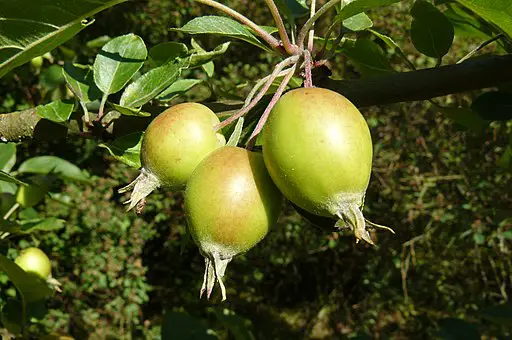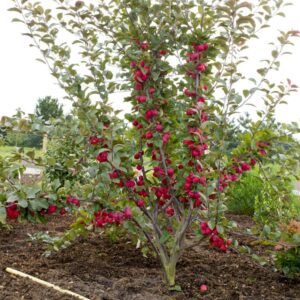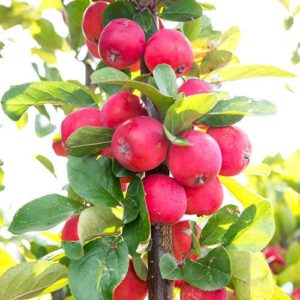With the potential to reach an impressive height of 12 metres, the Malus John Downie crab apple tree variety is a popular one.

Its pretty pink buds forming early spring make way for wonderful white flowers which, in the autumn, become bright red and orange apples.
John Downie crab apple trees can be grown as full size, container-grown, or fan-trained. This means they appeal to many gardeners with different levels of experience and garden size.
Jump To...
Fruit Appearance & Taste
The John Downie variety is one of the most well-known crab apples, not least due to its overall quality and taste.
The apples are oval in appearance and once they are ready to pick in the autumn, make wonderful crab apple jelly. As well as enjoying the fruit itself, you will be able to enjoy the hints of autumn foliage that flourish during harvesting time.
Growing & Care of Malus John Downie
Pink buds on John Downie crab apple trees open up to vivid white flowers in April, sometimes earlier if the weather is mild.
The white blossom signals the start of spring and the 5 petalled flowers are very popular for the early pollinators.
The John Downie crab apple tree has green foliage and in autumn this has hints of reds and oranges. The fruit itself looks a bit like an upside-down pear and its colours are a mixture of red and orange.
Harvesting
Crab apples will be ready to pick in the Autumn and any left on the tree will be enjoyed by the wildlife. This beautiful variety of tree is fairly easy to grow and can produce plentiful crop sizes.
On average, Malus John Downie crab apple trees will bear fruit between 2 and 5 years. The height and spread of crab apple trees will depend on the type you purchase. At their highest they can reach 12 metres tall but there are many more modest dwarf varieties.
Key Features
- Best Feature: The best apple for crab apple jelly
- When To Plant Out: Any time of the year
- Harvest Fruit: October and November
- Best Growing Position: Full Sun & Part Shade
- Soil Type: Any well-drained soil
Common Problems
As with most fruit types, John Downie crab apple trees can attract some apple tree pests and diseases. We list a few of the most common below:
- Aphids: In extreme cases, aphids can cause damage to the leaves of apple trees. Leaves can become curled or twisted and can lead to poorly developed shoots. In most cases though, aphids can be controlled by attracting predators such as lacewings and hover flies.
- Blossom Wilt: Blossom wilt is caused by a fungal infection which can also affect cherry and plum trees. Signs of blossom wilt include flowers shrivelling up and early drop and you may notice leaves turning brown too. This can only be dealt with by removing any signs of disease and then burning the offcuts.
- Powdery Mildew: Should you notice a white powder on your crab apple leaves then you may well have powdery mildew. This is basically a mould that forms which can affect the growth of leaves, flowers, and the fruit itself.
History of Malus John Downie
John Downie crab apples were named so after a nurseryman in Scotland who was a friend of Mr Edward Holmes.
It was first raised in England during the 1870s and soon became one of the most popular crab apple varieties. It makes a lovely ornamental tree as well as being very fruitful.
Eating Malus John Downie
Firm, crunchy and full of flavour makes John Downie crab apples incredibly moreish. They are also one of the best varieties for making crab apple jelly or jam due to the high levels of pectin.
With these fruits, there is no need to add any gelatine which is easier and more convenient. This variety is egg-shaped and a good size, with plentiful crops during the autumn.
FAQ’s
John Downie crab apples will be ripe in the Autumn months so anytime from October onwards. They can continue to ripen into the winter – much of this is weather-dependent.
Your John Downie crab apples are ready to pick when they fall from the tree when it is shaken. Do not attempt this without popping a blanket or sheet underneath, otherwise you will spend a long time gathering them. You can cut one to see if it is ready – if the seeds are brown then it is ready to eat.
Malus John Downie crab apples will be loved by a range of birds including thrushes, blackbirds, blackcaps, and finches. They will also attract bees, butterflies and hoverflies with their bright white blossoms.





